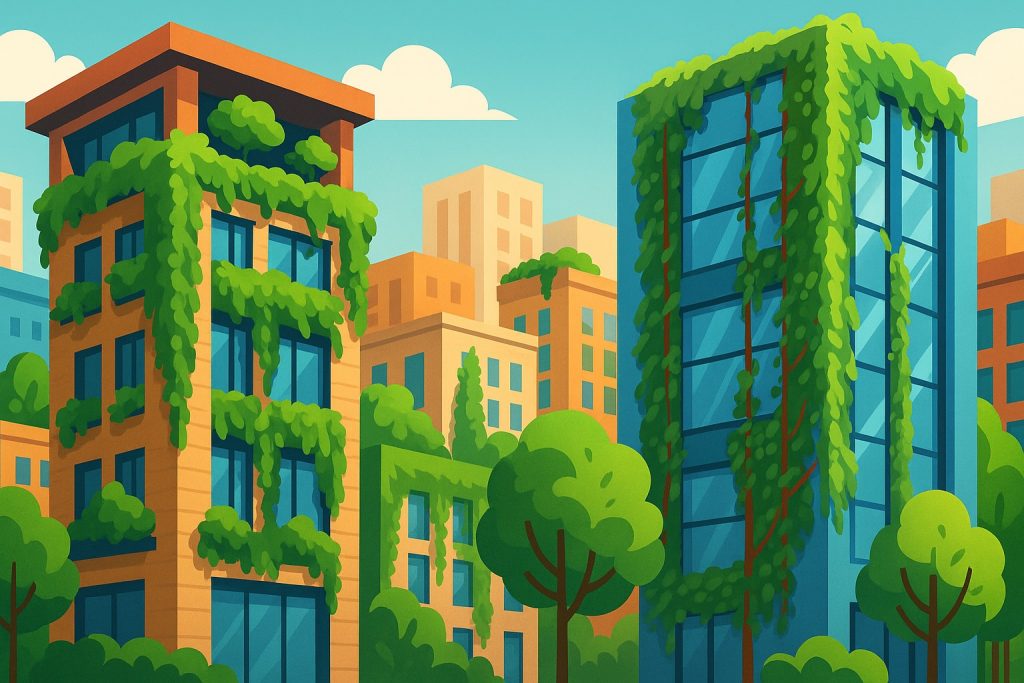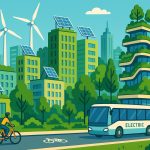As urban environments grow denser and taller, the need for green spaces becomes more urgent. Vertical gardens and green facades offer an innovative solution—transforming bare building walls into living ecosystems. These green features not only beautify cities but also serve crucial environmental and health functions.
What Are Vertical Gardens and Green Facades?
- Vertical garden (also known as a living wall): A structure with built-in irrigation and soil (or hydroponics) that allows plants to grow vertically on interior or exterior walls.
- Green facade: A system where climbing plants, such as ivy or vines, grow up walls or on support structures like trellises or cables.
While both approaches use plants on buildings, vertical gardens are typically more engineered, while green facades rely on natural climbing growth.
Environmental Benefits
1. Improved Air Quality
Plants filter out pollutants like nitrogen dioxide and dust particles. They also absorb carbon dioxide and release oxygen, helping combat urban smog.
2. Temperature Regulation
Vertical vegetation reduces the urban heat island effect by:
- Providing shade
- Evaporating water, which cools surrounding air
- Insulating buildings, reducing the need for air conditioning
3. Stormwater Management
Green walls can absorb rainwater, easing the burden on city drainage systems and helping prevent flooding.
4. Noise Reduction
Plant-covered surfaces absorb and deflect sound, offering quieter environments in noisy urban areas, especially near roads or public spaces.
Urban and Human Benefits
1. Enhanced Aesthetics
Vertical greenery transforms dull concrete into lush, natural surfaces that beautify neighborhoods and commercial spaces.
2. Improved Mental Health
Studies show that greenery—especially in urban settings—reduces stress, improves mood, and encourages a sense of wellbeing.
3. Biodiversity Support
Green facades provide habitats for birds and pollinators, even in heavily built-up areas.
4. Increased Property Value
Buildings with living walls are seen as more attractive, innovative, and energy-efficient, which can raise market value and attract tenants.
Challenges and Considerations
- Installation costs can be high, especially for advanced vertical garden systems.
- Maintenance is essential: irrigation, pruning, pest control, and replacing dead plants.
- Structural support must be planned to handle the weight and moisture of the system.
- Plant selection should consider local climate, sunlight, and exposure.
Successful Examples
- The Green Wall at CaixaForum, Madrid: A striking living wall combining architecture and botany.
- One Central Park, Sydney: Skyscraper with over 1,000 square meters of vertical gardens.
- Bosco Verticale, Milan: Twin residential towers covered with over 900 trees and 20,000 plants.
- Singapore’s “Supertree Grove”: Vertical gardens with solar panels and environmental sensors.
Future of Urban Greening
As climate challenges intensify, vertical gardens and facades are likely to become standard in sustainable architecture. Cities may integrate them into:
- Building codes and green certifications
- Public spaces and infrastructure
- Green corridors to connect fragmented habitats
- Interior spaces in offices and homes for cleaner indoor air
Glossary
- Urban heat island – A phenomenon where city temperatures are higher than surrounding areas due to heat-absorbing surfaces like asphalt and concrete.*
- Stormwater – Rainwater that runs off roofs, streets, and other surfaces, often carrying pollutants.*
- Biodiversity – The variety of living organisms in a particular area, including plants, animals, and microorganisms.*
- Hydroponics – A method of growing plants without soil, using nutrient-rich water instead.*


